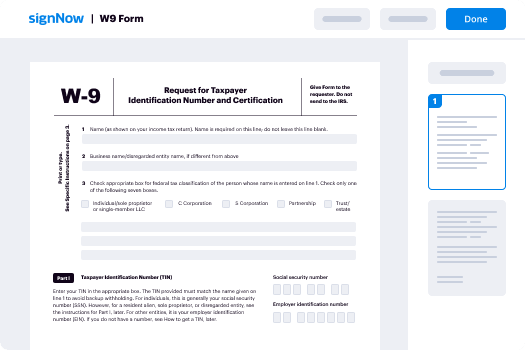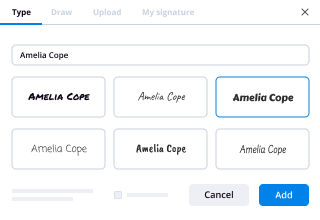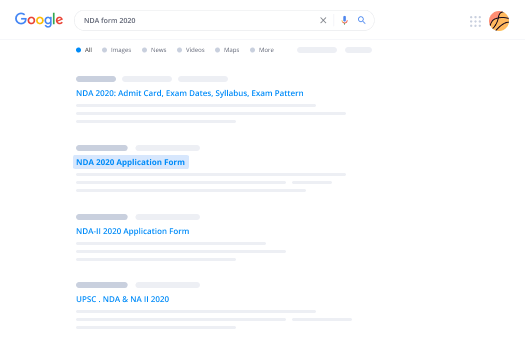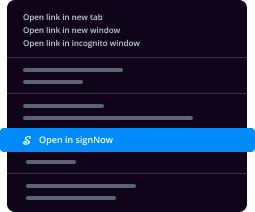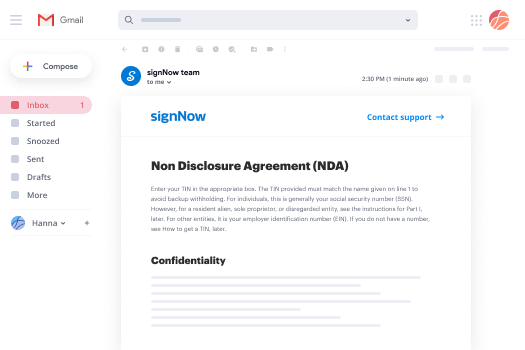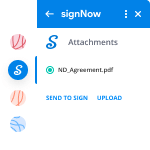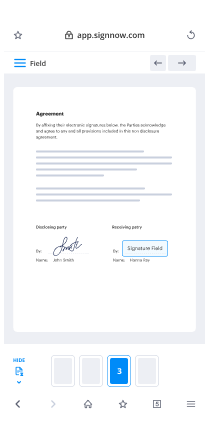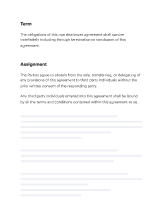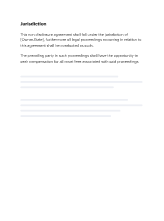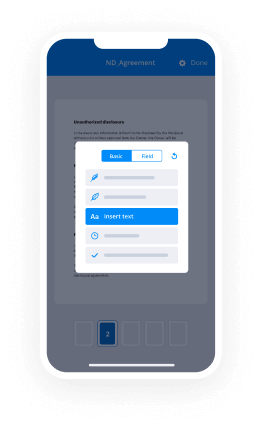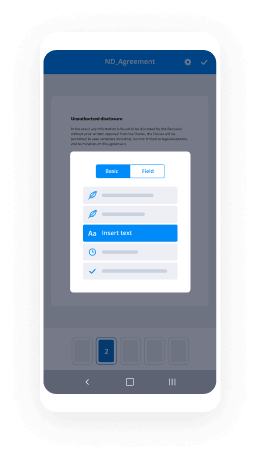Avantages Et Inconvénients De La Signature Numérique : Guide Rapide
- Démarrage rapide
- Facile à utiliser
- Support 24/7
Les entreprises qui pensent à l'avance dans le monde entier font confiance à airSlate pour le moment






Guide de démarrage rapide sur l'utilisation des avantages et des inconvénients de la fonctionnalité de signature numérique
Votre organisation est-elle prête à réduire les inefficacités d'environ trois quarts ou plus ? Avec airSlate SignNow eSignature, des semaines de négociation de contrat deviennent des jours, et des heures de collecte de signatures se transforment en minutes. Vous n'aurez pas besoin d'apprendre tout depuis le début grâce à l'interface conviviale et aux guides faciles à suivre.
Suivez les étapes ci-dessous pour utiliser les avantages et les inconvénients de la fonctionnalité de signature numérique en quelques minutes :
- Lancez votre navigateur et accédez à signnow.com.
- Abonnez-vous pour un essai gratuit ou connectez-vous en utilisant votre e-mail ou vos identifiants Google/Facebook.
- Cliquez sur Avatar Utilisateur -> Mon Compte dans le coin supérieur droit de la page web.
- Modifiez votre Profil Utilisateur avec vos données personnelles et ajustez les configurations.
- Concevez et gérez votre(s) Signature(s) par Défaut.
- Retournez à la page du tableau de bord.
- Survolez le bouton Télécharger et Créer et choisissez l'option nécessaire.
- Cliquez sur le bouton Préparer et Envoyer à côté du titre du document.
- Entrez le nom et l'adresse e-mail de tous les signataires dans l'écran contextuel qui s'ouvre.
- Utilisez le menu Commencer à ajouter des champs pour continuer à modifier le fichier et le signer vous-même.
- Cliquez sur ENREGISTRER ET INVITER une fois terminé.
- Continuez à configurer votre flux de travail eSignature en utilisant des fonctionnalités supplémentaires.
Il n'a jamais été aussi simple d'utiliser les avantages et les inconvénients de la fonctionnalité de signature numérique. Elle est également accessible sur vos appareils mobiles. Installez l'application airSlate SignNow pour iOS ou Android et gérez vos flux de travail eSignature personnalisés même en déplacement. Évitez l'impression et la numérisation, le classement chronophage et la livraison de documents coûteuse.
Comment ça marche
Évaluez votre expérience
Understanding the advantages and disadvantages of digital signatures
Digital signatures offer a variety of benefits that enhance the efficiency and security of document signing processes. One significant advantage is their ability to provide authenticity and integrity. When a document is signed digitally, it ensures that the signer's identity is verified, and any changes to the document after signing can be detected. This level of security is crucial for sensitive agreements and contracts.
However, there are disadvantages to consider. One potential drawback is the reliance on technology. If users lack access to the necessary devices or internet connectivity, they may face challenges in signing documents electronically. Additionally, some individuals may be unfamiliar with the technology, leading to a learning curve that could hinder adoption.
How to effectively use digital signatures
To maximize the benefits of digital signatures, it is essential to understand how to implement them within your workflow. Begin by selecting a reliable eSignature platform, such as airSlate SignNow, that meets your business needs. Once you have access, you can easily upload documents, fill out required fields, and send them for signature.
When preparing a document for eSigning, ensure that all parties are informed about the process. Clear communication can help alleviate any concerns regarding the technology and make the signing experience smoother. After receiving signed documents, utilize the platform's features to store and manage these files securely.
Legal considerations for digital signatures
In the United States, digital signatures are legally recognized under the Electronic Signatures in Global and National Commerce (ESIGN) Act and the Uniform Electronic Transactions Act (UETA). These laws establish that electronic signatures hold the same legal weight as traditional handwritten signatures, provided certain conditions are met. It is essential to ensure that the digital signature process complies with these regulations to maintain the enforceability of signed documents.
Additionally, different states may have specific rules regarding the use of digital signatures. Familiarizing yourself with these regulations can help ensure compliance and prevent potential legal issues.
Steps to complete a document using digital signatures
Completing a document with a digital signature involves a straightforward process. Start by uploading the document to your chosen eSignature platform. Next, identify the fields that require completion, such as names, dates, and signatures. Use the platform's tools to fill in these fields accurately.
Once the document is prepared, you can send it for signature. Enter the email addresses of the signers, and the platform will notify them to review and sign the document electronically. After all parties have signed, you will receive a final copy, which can be securely stored or shared as needed.
Security and compliance guidelines for digital signatures
Ensuring the security of digital signatures is paramount. When using an eSignature platform, look for features that provide encryption and secure storage. These measures protect sensitive information and maintain the integrity of signed documents.
Compliance with legal standards is also critical. Make sure that the platform you choose adheres to the relevant regulations, such as the ESIGN Act and UETA. Regular audits and updates to security protocols can further enhance compliance and safeguard against potential risks.
Risks of not using eSignatures properly
Failing to implement digital signatures correctly can lead to several risks. One major concern is the potential for fraud. Without proper verification processes, unauthorized individuals may sign documents, leading to disputes and legal challenges.
Additionally, not adhering to compliance regulations can result in the invalidation of signed documents. This situation can create complications in business transactions and damage trust between parties. Therefore, it is crucial to follow best practices when utilizing digital signatures to mitigate these risks.
Obtenez dès maintenant des signatures juridiquement contraignantes !
-
Meilleur ROI. Nos clients obtiennent un ROI 7 fois en moyenne au cours des six premiers mois.
-
Échelle avec vos cas d'utilisation. De SMB à moyen marché, airSlate SignNow fournit des résultats pour les entreprises de toutes tailles.
-
Interface utilisateur intuitive et API. Signez et envoyez des documents depuis vos applications en quelques minutes.
Signature en ligne de la FAQ
-
What are the main advantages and disadvantages of digital signature?
The advantages of digital signatures include enhanced security, faster document turnaround times, and reduced paper usage. However, some disadvantages may include the need for technology adoption and potential legal complexities in certain jurisdictions. Understanding these advantages and disadvantages of digital signature can help businesses make informed decisions. -
How does airSlate SignNow address the disadvantages of digital signatures?
airSlate SignNow mitigates the disadvantages of digital signatures by providing user-friendly technology and comprehensive support. Our platform ensures compliance with legal standards, making it easier for businesses to navigate potential complexities. By addressing these disadvantages, we enhance the overall advantages of digital signature for our users. -
What features does airSlate SignNow offer to maximize the advantages of digital signatures?
airSlate SignNow offers features such as customizable templates, real-time tracking, and secure cloud storage. These features maximize the advantages of digital signatures by streamlining workflows and improving efficiency. By leveraging these tools, businesses can fully benefit from the advantages of digital signature technology. -
Is airSlate SignNow cost-effective compared to traditional signing methods?
Yes, airSlate SignNow is a cost-effective solution compared to traditional signing methods. By reducing the need for paper, printing, and postage, businesses can save signNowly on operational costs. This cost-effectiveness is one of the key advantages of digital signature solutions like airSlate SignNow. -
Can airSlate SignNow integrate with other software to enhance its digital signature capabilities?
Absolutely! airSlate SignNow integrates seamlessly with various software applications, enhancing its digital signature capabilities. This integration allows businesses to streamline their processes and maximize the advantages of digital signatures across different platforms. -
What industries can benefit from the advantages of digital signatures?
Many industries, including real estate, finance, and healthcare, can benefit from the advantages of digital signatures. These sectors often require secure and efficient document handling, making digital signatures an ideal solution. Understanding the advantages and disadvantages of digital signature in your industry can lead to better operational efficiency. -
How secure are digital signatures compared to traditional signatures?
Digital signatures are generally more secure than traditional signatures due to encryption and authentication processes. They provide a higher level of security, reducing the risk of fraud and unauthorized access. This security is a signNow advantage of digital signatures, outweighing some of the disadvantages associated with their use.
Votre guide complet
Rejoignez plus de 28 millions d'utilisateurs airSlate
Obtenir plus
- Déverrouillez le pouvoir de la légalité de la ...
- Déverrouillez le pouvoir de la légalité de la ...
- Déverrouillez le pouvoir de la légalité de la ...
- Assurer la légalité de la signature électronique ...
- Légalité de la signature électronique pour l'acte de ...
- Légalité de la signature électronique pour l'accord ...
- Légalité de la signature électronique pour l'acte de ...
- Assurer la légalité de la signature électronique ...




















